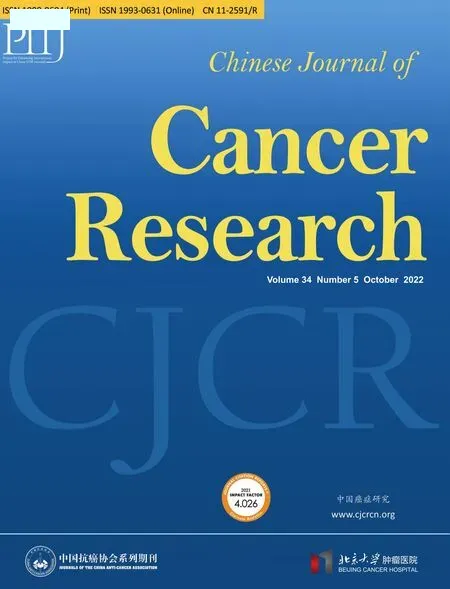Comments on National guidelines for diagnosis and treatment of cervical cancer 2022 in China (English version)
Naiyi Zhang,Yunong Gao
Key Laboratory of Carcinogenesis and Translational Research (Ministry of Education/Beijing),Department of Gynecologic Oncology,Peking University Cancer Hospital&Institute,Beijing 100142,China
National guidelines for diagnosis and treatment of cervical cancer 2022 in China (English version)(1) draws on the internationally recognized guidelines for the diagnosis and treatment of cervical cancer,and is revised on the basis of the 2018 edition guidelines in combination with actual medical resources as well as characteristics of the diseases specific to China.The standard of diagnosis and treatment of cervical cancer is applicable to cervical squamous cell carcinoma,adenocarcinoma and adenosquamous carcinoma,but not for other rare pathological types.In clinical practice,the treatment of cervical cancer pays attention to the concept of standardized comprehensive treatment and the needs of individualized treatment.It is necessary to comprehensively evaluate the hospital’s equipment,technical conditions and patients’ condition to formulate a treatment plan.
National guidelines for diagnosis and treatment of cervical cancer 2022 in China (English version)adopts the clinical staging standards for cervical cancer revised by the International Federation of Gynecology and Obstetrics(FIGO) 2018 meeting.Clinical examinations combined with imaging and pathological examinations for staging can better reflect the clinical characteristics of cervical cancer,and is closer to clinical practice,which is conducive to accurate staging and selection of appropriate treatment methods.In the diagnosis of stage IA cervical cancer,the width of horizontal interstitial invasion is no longer considered,and the new standard distinguishes stages IA1 from IA2 only based on the depth of interstitial invasion.It also refines the sub-staging of stage IB,from the original 2 sub-staging to 3 sub-staging,which is more conducive to the selection of postoperative adjuvant therapy and prognosis of patients.The last important change is the inclusion of lymph node metastases in the staging system,defining lymph node metastases as stage IIIC,and adding evidence of lymph node metastases (r represents imagingdetected lymph node metastases,p represents pathological confirmation).On the basis of clinical staging,this staging system uses imaging and pathological methods to further supplement the staging information of lymph node metastasis,which can guide the treatment and prognosis evaluation of cervical cancer more effectively.
In the diagnosis of cervical cancer,imaging examinations mainly helps understand the extent of tumor metastasis and invasion,including evaluation of the extent of local tumor invasion,lymph node metastasis and distant organ metastasis,etc.,so as to guide clinical decision-making and evaluate efficacy.Pelvic magnetic resonance imaging (MRI)is the first choice of imaging diagnosis to evaluate local lesions,and it is necessary to carefully evaluate the tumor status of the whole body,and if necessary,whole-body positron emission tomography-computed tomography(PET-CT) examination is performed.
The main treatment methods for cervical cancer include surgery and radiotherapy.Chemotherapy is widely used in combination therapy with surgery and radiotherapy as well as in the treatment of advanced recurrent cervical cancer.Surgical treatment is mainly used for early-stage cervical cancer,and concurrent chemoradiotherapy instead of surgery is advocated for advanced cervical cancer.Regarding the choice of surgical approach,the guidelines state that extrafascial hysterectomy (type I or A) can be performed through vaginal or open or minimally invasive(laparoscopic and robotic laparoscopy) approaches.Prospective randomized controlled trials have shown that minimally invasive radical hysterectomy is associated with lower disease-free and overall survival rates compared with open radical hysterectomy.
In recent years,with the in-depth progress of clinical research,the decision-making of cervical cancer diagnosis and treatment has gradually entered the era of precision.The main update of the new guideline is mainly reflected in the application of immunotherapy.Based on the results of Keynote-826,immunotherapy entered the first-line treatment recommendation.There are important changes in the first-line combination therapy for recurrent and metastatic cervical cancer (squamous cell carcinoma,adenocarcinoma and adenosquamous carcinoma),and guidelines recommend pembrolizumab combined with chemotherapy and bevacizumab for programmed deathligand 1 (PD-L1)-positive patients.In second-line treatment of cervical cancer after failure of first-line therapy,pembrolizumab is recommended for cervical cancer with positive PD-L1 or high microsatellite instability/mismatch repair deficiency.
Clinicians should follow the guidelines to conduct clinical diagnosis and treatment decisions,standardize diagnosis and treatment behaviors,so as to improve diagnosis and treatment outcomes and quality.And accurate individualized clinical decisions should be made by taking clinical practice as the starting point in clinical work,combining with specific medical practice and the specific situation of cervical cancer patients.At the same time,high-quality multi-center and large-sample clinical research should be carried out for domestic cervical cancer population,which will not only promote the development of cervical cancer treatment in China,but also provide more data points to the global cervical cancer diagnosis and treatment.
Acknowledgements
None.
Footnote
Conflicts of Interest: The authors have no conflicts of interest to declare.
 Chinese Journal of Cancer Research2022年5期
Chinese Journal of Cancer Research2022年5期
- Chinese Journal of Cancer Research的其它文章
- Characteristics of lymph node stations/basins metastasis and construction and validation of a preoperative combination prediction model that accurately excludes lymph node metastasis in early gastric cancer
- Correlation between imaging features on computed tomography and combined positive score of PD-L1 expression in patients with gastric cancer
- Evaluation of triage strategies for high-risk human papillomavirus-positive women in cervical cancer screening: A multicenter randomized controlled trial in different resource settings in China
- Colorectal cancer burden,trends and risk factors in China:A review and comparison with the United States
- Myeloid checkpoints for cancer immunotherapy
- National guidelines for diagnosis and treatment of malignant lymphoma 2022 in China (English version)
